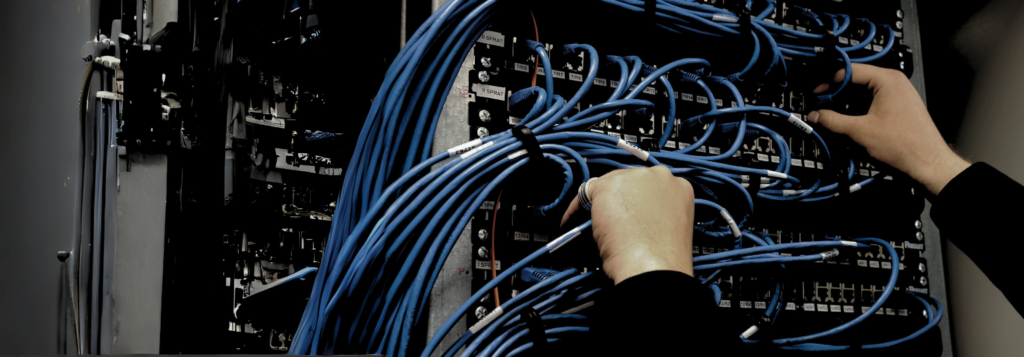Halloween is nearly here, and while preparing for the traditional costume party at the office, as the practice owner, a spooky thought enters your mind: When it comes to moving to the cloud, wat if your IT guy has been tricking you (instead of treating you) all this time?
Well, you thought about moving your practice management software to the cloud – as many other recent dental grads nowadays do – however, your IT guy seems to always give a myriad of reasons why moving to the cloud would not be in your best interest at this time.
Okay then, let’s explore together – and potentially debunk – the top 10 (mythical) reasons why moving your dental software to the cloud would supposedly not be in your best interest.
Myth 1: Moving your patients’ data to the cloud means giving up ownership of your data to the cloud vendor, and perhaps you’ll get stuck with that cloud vendor forever.
Debunk: Your patient’s data is always yours – and the cloud vendor is obligated by law to make it available to you in an accessible format, by request, at any time – including if and when you choose to discontinue the cloud service, and for any reason.
Myth 2: Cloud-based vendors are fast and loose with privacy, encryption, and HIPAA compliance; your IT guy can control privacy and ensure compliance much better, right?
Debunk: Cloud-based vendors have a lot more IT resources, much more qualified IT personnel, and follow better processes than you can afford for your practice. Moreover, all cloud vendors offer Service Level Agreements that guarantee encryption, security, and uptime far in excess of what a local IT contractor can provide for your “server in a closet” configuration – and they all sign HIPAA Business Associate agreements with your practice that makes them responsible for your patients’ data integrity, privacy, and timely recovery in the unlikely case of equipment malfunction.
Myth 3: When the Internet goes down, you cannot run your practice with a cloud-based system.
Debunk: It is true that if you rely on a single Internet provider and that provider goes down, you lose connectivity, and you cannot see patients that day. However, most business-grade Internet routers today come with auto-failover, dual (or even quadruple) Internet services at a very affordable cost – meaning that your main Internet connection can be with Comcast, while your secondary (auto-failover) can be a 5G fixed service with T-Mobile or Verizon (they go for about $50 / month these days).
But wait, there’s more: Some of the more advanced cloud platforms of recent design are optimized for Wi-Fi mobility (touch tables or laptops) – and in the very rare occasions when your wired Internet connection goes down, you can always connect that laptop or tablet through your mobile phone in hotspot mode. With this option, in case of emergency, you can even see patients in your parking lot.
Myth 4: Moving your dental software to the cloud will make it more difficult to maintain your current integrations with your patient engaging system (Dental / Ortho Sesame, etc.), your social media integration/reputation management system (Birdeye, etc.), your patient acquisition system (your practice’s website, ZocDoc, etc.), your payment processing/patient billing/claims management system (OrthoBanc, etc.), and all the other little software add-ons that you have accumulated over the years?
Debunk: There is no real reason to stick with all these little add-on extensions to your old practice management system (many are becoming obsolete by now anyway). Most, if not all, cloud vendors worth their salt have their own integration partners to accomplish essentially the same goals as these — and perhaps in a better, faster, cheaper way. All you have to do is ask.
But wait, there’s more: A well-chosen dental software platform will include native, built-in features that replace all of these cottage-industry add-ons, saving you money, headaches, and vendor finger-pointing when data does not flow as intended.
Myth 5: Imaging does not work well in the cloud. Webpage-based software is restricted by the browser’s sandbox and cannot directly integrate with your digital X-ray and other imaging equipment. And we’re not even talking about 3D imaging (like CBCT, 3-D optical scans, 3-D digital molds, etc.). These hardware-tied, memory-intensive capabilities cannot be implemented in a browser, right? Does this mean you will have to keep your old Apteyx software – or similar – to view and manage your patients’ images in a separate system that might not even be available in the cloud?
Debunk: While it is generally true that webpage-based software cannot directly integrate with most digital imaging equipment due to web browser sandbox restrictions, most cloud vendors work their salt offer add-ons that acquire and then upload (mostly) 2D images into their cloud database as part of the patient’s file. 3D (like CBCT) image acquisition/upload is, however, a lot rarer, as the complexity of 3D is much higher and the amounts of data involved are massive.
But wait, there’s more: A “cloud platform” does not necessarily need to be webpage-based (webpages are easy). It can be implemented as a “SuperApp” instead (much harder). We have all kinds of Apps on our phones, and they do lots of powerful things – similarly, a “SuperApp” dental platform will offer you all the benefits of a webpage with none of its limitations, meaning yes, you can acquire 2D – and even 3D – images directly into the cloud-based patient’s file in one, simple step. You can view these in their entire 2D / 3D splendor directly from the cloud-based patient’s file as well.
Myth 6: Your staff will take a long time retraining on a new platform, and the transition will be painful to your practice.
Debunk: It is true that most legacy dental software designed in the 1970s was very poorly designed. It took a lot of training to learn all the nooks and crannies of every little feature and sub-feature of every module within the app. Modern application design, especially cloud-based, has come a long way as websites must be so intuitive as to not require any training – otherwise Apple and Amazon would go out of business. Moreover, with the advent of Google and YouTube, help and training videos are only a few clicks away.
But wait, there’s more: Some of the more advanced cloud platforms of recent design, in addition to being extremely intuitive and designed with consistency and usability in mind, also include context-sensitive help and built-in training videos available within the application. As a result, your existing staff’s (and new hires’) total retraining time is measured in hours – not days.
Myth 7: You have taken all this time to configure your legacy practice management system with all of your practice-specific CDT codes, billing schedules, insurance coverages accepted, etc. just the way you wanted, and you don’t want to go through all that pain again to switch to a new system.
Debunk: Things change all the time, and you have to keep these configuration parameters updated in your legacy practice management system as well. The difference lies in how easy it is to update and maintain these parameters; with an arcane legacy system, it actually might take more time to do an annual refresh/update than it might take to set up your practice from scratch with a new, much more modern system.
But wait, there’s more: Some of the more advanced cloud platforms of recent design will also automatically update themselves every time a new CDT code is added or modified, every time a new insurance coverage becomes available, etc.
Myth 8: You already spent all that money when you purchased your Dentrix / Eagle Soft / Dolphin / Ortho II / Soft Dent / etc. software, and moving to the cloud will cost you an extra amount of money every month, right?
Debunk: Even if you purchased your original system way back and all that money has been spent, you still have to pay for a maintenance plan to keep your software current – just to stay compliant with HIPAA regulations, if nothing else. Moreover, the monthly subscription fee for a Software-As-A-Service (SaaS) platform will generally be much less than the Total Cost of Ownership (TCO) of a traditional system. Just ask your cloud vendor to do a quick analysis before you commit.
Myth 9: Cloud vendors charge a monthly hosting fee in addition to the licensing fee. I don’t have to pay that fee with my on-premise legacy software.
Debunk: As a matter of fact, you do – but it’s not immediately obvious (courtesy of your IT guy, haha). Server hardware must be replaced every 3-5 years as they age (especially with constant use), the server must be fixed when it breaks, server operating systems must be upgraded and patched periodically, server backups must be made daily and stored off-site, your practice management software must be upgraded every time a new release is made available by the vendor, anti-virus software definitions must be updated frequently, and most importantly – server security and error logs must be audited periodically, to stay compliant with HIPAA-HITECH. When you add all the IT labor costs for all these tasks together with the incidental server parts and average them over the useful life of your on-premises software, the cloud hosting fee will seem like a pittance in comparison. When moving to the cloud, your IT guy stands to lose an important source of revenue – or even become redundant to your practice – so no wonder they’re advising you to keep your legacy on-premise system with all of those add-ons, patches, and facelifts from the vendor.
Myth 10: The cost of licensing a cloud-based platform is much higher than if you were to purchase licenses for your on-premise legacy software.
Debunk: Most on-premise legacy software is licensed either on a per-computer basis or on a per-user basis, In the former case, if you have 25 computers in your practice and only 5 staff members attending to patients at any one time, you’d have to purchase 25 computer licenses (one for each computer). In the latter case, if you employ a lot of temps (say 25-ish from a temp agency) and only 5 of them attend to patients at any one time, you’d have to purchase 25 licenses as well. You could buy just 5 user licenses and use generic logins like staff/doc/front-desk and share passwords but would be a violation of HIPAA regulations because HIPAA requires explicit records of the specific individuals who accessed/updated/removed all elements of your patient’s Protected Health Information or PHI – so no, don’t share passwords.
But wait, there’s more: Some of the more advanced cloud platforms of recent design are licensed on a “concurrent user” (server access) basis – meaning that in both examples above, you would only have to purchase 5 “concurrent user” licenses. Any time a computer breaks, you’d just replace it and go; any time you get a new staff member or temp worker, you’d just create a new login for them and go.
In conclusion: Dental and orthodontic practices have much to gain by transitioning to a cloud-based dental software platform solution – and we’re not even talking about the ease of adding a new office across town, or perhaps the benefit of working from home for your staff. While on-premise solutions have served dental and orthodontic practices well for years, they come with inherent limitations, hidden costs, and potentially severe vulnerabilities. Cloud-based systems offer superior accessibility, reliability, and cost-effectiveness that also offer better security, convenience, and peace of mind.
Spooky final thoughts: Do your own research, make an informed decision, and above all, don’t let your IT guy hold you hostage through fear, uncertainty, and doubt!




